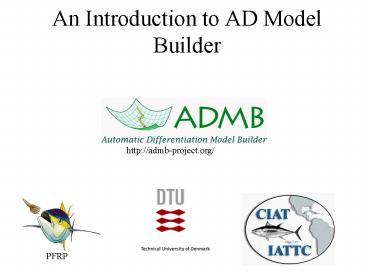An Introduction to AD Model Builder - PowerPoint PPT Presentation
1 / 18
Title:
An Introduction to AD Model Builder
Description:
Mark Maunder (Inter-American Tropical Tuna Commission, IATTC) Introduce ... high dimensional and ragged arrays. estimation of the variance-covariance matrix ... – PowerPoint PPT presentation
Number of Views:150
Avg rating:3.0/5.0
Title: An Introduction to AD Model Builder
1
An Introduction to AD Model Builder
http//admb-project.org/
2
Instructors
- Anders Nielsen (Technical University of Denmark,
DTU-Aqua) - Johnoel Ancheta (Pelagic Fisheries Research
Program, PFRP) - Mark Maunder (Inter-American Tropical Tuna
Commission, IATTC)
3
Introduce yourself
- Name
- Organization
- Main research
4
Questionnaire
- What do you know
- Remember to ask Participants about WinBUGs.
5
What is AD Model Builder
- Tool for developing nonlinear models
- Efficient estimation of model parameters
- C libraries
- Template
6
Simplifying the development of models
- Removes the need to manage the interface between
the model parameters and function minimizer. - The template makes it easy to input and output
data from the model, set up the parameters to
estimate, and set up objective function to
optimize (minimize). - Adding additional estimable parameters or
converting fixed parameters into estimable
parameters is a simple process. - ADMB is very flexible as model code is in C
- Experienced C programmers to create their own
libraries
7
Efficient and stable function minimizer
- Analytical derivatives
- Adjoint code
- Chain rule
- More efficient and stable than other packages
that use finite difference approximation. - Stepwise process to sequentially estimate the
parameters - Bounds on all estimated parameters that restrict
the range of possible parameter values.
8
MCMC algorithm for Bayesian integration
- Starts at the mode of the posterior reduces the
burn-in time. - Jumping rules based on the variance-covariance
estimates at the mode of the posterior
distribution
9
Automated likelihood profiles
- Normal approximation of confidence intervals
based on the Hessian matrix and derived
quantities using the delta method - Automatically calculate likelihood profiles for
model parameters and derived quantities producing
asymmetrical confidence intervals
10
Random effects parameters
- Random effects parameters implemented using
Laplaces approximation (and importance sampling) - Automatic analytical second derivatives.
- Use for process error or meta analysis
11
Matrix algebra
- Matrix algebra with associated precompiled
adjoint code for derivative calculations - Can greatly reduce computation time and memory
usage compared to loops
12
Other features
- non-linear programming solver
- numerical integration routine
- random number generation
- high dimensional and ragged arrays
- estimation of the variance-covariance matrix
- dynamic link libraries with other software
products (e.g. s-plus, Excel, Visual Basic) - safe mode compiling for bounds checking
- ability to make ADMB C libraries.
- Parallel processing
13
What its good for Highly parameterize nonlinear
models
- Thousands of parameters
- Combining many data sets or analyses
- General Models
- Stock Synthesis (Rick Methot NMFS)
14
What its good for Nonlinear models with large
data sets
- Integrating GLMs into nonlinear models
15
What its good for Numerous optimizations of the
objective function
- Simulation analysis
- Likelihood profiles
- Bootstrap/cross validation
- Model testing/sensitivity analysis
- Management strategy evaluation
- Numerical integration/simulated likelihood
16
What its good for Nonlinear mixed effects models
- Crossed random effects
- Nonlinear state-space models.
17
The ADMB project
- Make ADMB Free
- Make ADMB open source
- Develop ADMB
- Facilitate the use of ADMB
- Promote ADMB
18
Outline
- Introduction
- Installation
- First example
- Likelihood based inference
- What happens internally
- Parameter setup
- Data input and outputting results
- Simulation
- Estimating uncertainty
- Random effects
- Summary































